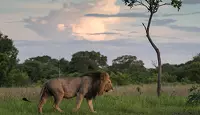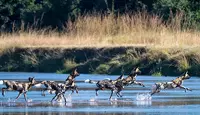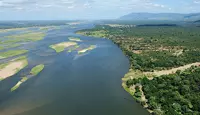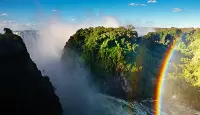Lusaka
Zambia’s capital since 1935, Lusaka began as a railway station in 1905. Today it is a mushrooming metropolis and one of the fastest growing cities in central Africa. Lusaka lies at an altitude of 4300 feet above sea level and enjoys a pleasant climate year ‘round. Lavender jacaranda trees abound, adorning parks, commercial areas, and high standard residential neighbourhoods. Although Lusaka is the stopping off point for most safaris in Zambia, the city offers its own unique attractions. Of special interest is the Munda Wanga Botanical Gardens and Zoo - an absolutely stunning 30-acre garden with over 300 local and foreign plant species, perennial stream, and a fine aviary and zoo. The Zambia Gemstone and Polishing Works produces very fine jewellery from precious and semi-precious stones, and the finished products are on display and for sale to visitors.
Some visitors pass rapidly through central Zambia, bypassing Lusaka’s chaotic traffic and sprawling suburbs; others overnight here. It is not a bad city, and many are surprised when they enjoy its tree-lined boulevards and vibrant street life. If you want to fly directly from Zambia to the UK, then the flights currently leave at 09:00. This may mean that it’s most convenient for you to spend your last night in Lusaka. If you want a hotel in town, then we recommend the Taj Pamodzi Hotel. Alternatively, a few spend an evening at Chaminuka, or stay nearby for a few nights at the delightful Lechwe Lodge - which is often a firm favorite
Livingstone
Justifiably known as the tourist capital of the country, Livingstone was named after the famous explorer who believed to have been the first European to see spectacular Victoria Falls. The magnificent Victoria Falls are known by the local people as Mosi-oa-tunya - “smoke which thunders”. The fall discovered by David Livingstone in 1885 and named after his Queen, is the result of the mighty Zambezi River tumbling to a depth of 300 feet over a basalt fault line a mile wide. They are one of the greatest natural wonders of the world and a must for any first time visitor to Zambia. There is far more to do at Victoria Falls than to marvel at the fall themselves; upstream where the Zambezi is calm and placid, sundowner cruises and gentle canoe trips along the game rich banks are the order of the day. But once the river has taken its plunge, there is quite a different experience to be had. For those with the courage, the rapids immediately downstream offer some of the most exciting white water rafting anywhere in the world. There is also a spectacular excursion to be made on foot. The Rainforest on the lip of the chasm opposite the fall is a unique swathe of dense tropical vegetation, which thrives on the spray thrown up throughout the year. But the ultimate view of this natural wonder can only be seen from the air. The ‘Flight of Angels’ provides a fabulous vista of the upstream river and its many islands, the spray from the fall as it is kicked a thousand feet into the sky, and the tortuous zigzag of the gorge downstream. To absorb all these experiences can take several days, as well as the 5 star Royal Zambezi hotel overlooking the Falls there are a number of hidden camps and lodges that allow you to enjoy the Livingstone area and the ever present Zambezi River at your own pace
South Luangwa National Park
The lush Luangwa Valley, enclosed by steep escarpment walls, is one of the African continent’s finest wildlife areas. The first settlers recognized the game in the majestic woodlands surrounding the Luangwa River as remarkable and in 1904 it became an officially protected area. South Luangwa National Park conserves most of the valley and riverine area, complete with ox-bow lakes and abandoned watercourses, as well as the more densely wooded areas reaching north and west - helped by the nearby North Luangwa National Park. There are several world-class safari camps along with excellent mobile and fly-camping options in the South Luangwa. In the South Luangwa valley you can find huge herds of elephant and buffalo, hundreds of animals strong, which are particularly spectacular if encountered whilst on foot. Impala and puku are prolific, while bushbuck, eland and kudu are often seen. Of particular interest are three unique subspecies: the beautiful Thornicroft’s giraffe, with its dark patterned skin, Crawshay’s zebra and Cookson’s wildebeest. The main predators are lion, leopard and spotted hyena, though wild dogs are occasionally seen. As well as exciting walks and drives with first-class guides, you can also rely on the camps for superb food and hospitality. As all the camps are slightly different in character, please call our team for an in-depth chat about them. We know them from personal experience, and can help you decide which would suit you best.
North Luangwa National Park
“Wilderness” is the best single word to describe this National Park, the first walking safaris were conducted here in the mid 80’s but since then only three safari operators have been adventurous enough to stake their territories here. Even today you are not allowed into the Park unless escorted professionally and there is only one road into the Park. As with the South Luangwa, the national Park is sandwiched between the Mchinga Escarpemnt and the Luangwa River itself, the habitats vary from wide grassy plains, through Mopane woodland to rich riverine forests hosting Acacias, Mahoganies and Sausage Trees. The Mwaleshi River is a tributary of the Luangwa that winds its way down the escarpment in a series of waterfalls and then across the valley floor, the river receeds during the dryer months of the year but remains attractive to many species of antelope and the large herds of Buffalo that are common in this Park. It is along this watercourse that walking safaris are conducted and accommodation is in small, remote camps.
Kafue National Park
About the same size as Wales, Kafue National Park is Zambia’s largest park and protects a wide variety of different environments on an undulating plateau veined by rivers. At its heart, the main Kafue River is wide, deep and slow, to the obvious pleasure of large numbers of hippo and crocodile. Tall, shady hardwoods overhang its banks, whilst occasional islands are favorite places for elephant and buffalo. Around the rivers a mosaic of miombo and riverine woodlands is dotted with occasional grassy pans, or dambos. This variety of habitats is perfect for game. Aside from the common species like impala, puku, zebra, blue wildebeest and kudu, Kafue’s attractions include rarer antelope like roan, sable, eland, oribi and Defassa waterbuck. Lion, leopard and cheetah thrive, as do growing numbers of Africa’s rarest large predators - wild dogs. One of Kafue’s main tributaries, the Lufupa River, enters the park via the Busanga Swamps. During the rains, it floods out over the adjacent Busanga Plains, and when the waters recede around May, they leave behind lush vegetation. This is a magnificent wilderness: flat grassland plains dotted with photogenic ‘islands’ of wild date palms, sausage trees and fig trees. It attracts huge herds of red lechwe and puku, as well as buffalo, zebra and wildebeest, followed by occasional cheetah and lion (known here for their tree-climbing antics).
The park is bisected in the middle by the Lusaka-Mongu road, and in many ways we can consider the north of Kafue National Park as quite different from the south side. Northern Kafue. For many years Southern Kafue has been largely ignored. The reality is that the game can is quite patchy, clustered around areas where it has historically been best protected. These areas have been expanding recently though, especially with the arrival of the excellent new Kaingu Lodge, which stands just south of a long-standing good area for game, Puku Pans.
Lower Zambezi National Park
The Lower Zambezi Valley is a huge rift in the earth’s crust, through which a mighty river flows. Over millennia, mineral-rich volcanic soils deposited by the Zambezi have nurtured lush vegetation, while old meanders and oxbow lakes add to the attraction for wildlife. The landscape is beautiful: tall leadwoods, ebonies, acacias and figs stand on a carpet of rich grassland. But the main attraction is the area’s game, which congregates near the river during the dry season. Buffalo graze on islands, often swimming between them, while impala are everywhere and kudu, eland, waterbuck, bushbuck, zebra and grysbok are common. The area is notable for its huge old bull elephants, which are often very relaxed individuals. Leopard, wild dog and spotted hyena are the major predators, with some unusually large prides of lion. The bird life is rich - 378 species have been recorded here, including many species of eagle, kingfisher, heron, stork and bee-eater. There is a range of great safari camps within the Lower Zambezi National Park, and just outside it.
United States citizens require a Zambia visa at this time. However, entry requirements do change from time to time, and it is advised that up-to-date information is obtained from an African safari travel agent, Zambia Airways, or a local tourist board.
Cholera inoculations are are strongly advised. Anti-malaria tablets are also well advised. Inoculation requirements and recommendations do vary; it is suggested that you consult with your personal physician prior to departure. Zambia is considered a high-risk malaria area with no low season. Casevac medical insurance recommended.
Zambia has a moderate climate due to its elevation, even though it lies well into the tropics. November to March is the rainy season. April to July - dry, warm days with cold nights. August to October - hot and dry.
Banks are open Monday, Tuesday, Thursday and Friday from 08h15 to 12h45. On Wednesday from 08h15 to 12h00 noon, Saturday from 08h15 to 11h00. The banks at Lusaka Airport are only open to meet international flights, and WILL NOT convert Zambia currency back into foreign money.
The Zambia currency is the Kwacha, meaning “dawn” in the Cinyanja language. A kwacha (k) is divided into 100 ngwee (n). All foreign currency must be declared upon entering Zambia, but there is no limit to the amount taken into the country. The import and export of local currency is forbidden. Credit cards are accepted only in the larger hotels, and are limited to American Express and Diners Club.
The official language of Zambia is English, and the visitor will have no problem getting around, understanding and being understood in Zambia. There are also 70 other tongues spoken throughout the country, most of which are closely related.
The major Zambian safari hotels offer fine continental cuisine and, in some of the larger cities, local restaurants provide international as well as local foods. The national dish of Zambia is nshima - pounded maize eaten with a peppery relish and meat. Mealie mealie is also popular, and is prepared with mushy fish and a cornflower dish. The national drink is chibuku, made from ground soyabeans. Beer lovers will appreciate the locally brewed Mosi beer; it has won every competition in this region of Africa.
Typical Zambian crafts include ceremonial masks, copper ware, malachite articles, Barotse basketry and jewellery crafted from precious and semi-precious stones.
In suburban areas, shops are open all day Monday through Saturday. Elsewhere, they are generally closed Wednesday and Saturday afternoons, and all day Sunday. The best souvenir sources are the museums, craft shops and curio sellers. Bartering is acceptable only with street vendors.
The electricity runs on 220 volts, 50 cycles, AC.
Tape water in Zambia is not safe to drink. Always purchase properly sealed bottled water from your hotel or lodge.
Zambia is regarded as very safe, although Lusaka can be dangerous at night. The more remote places like western Zambia don’t get regular travelers and visitors should be alert. The border with Congo should be avoided.



